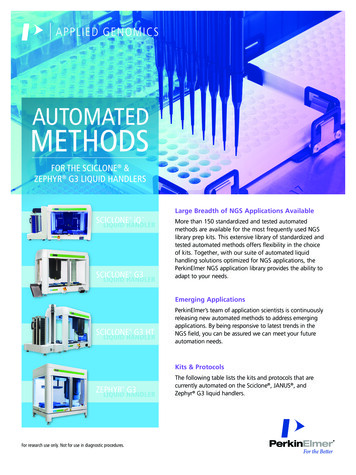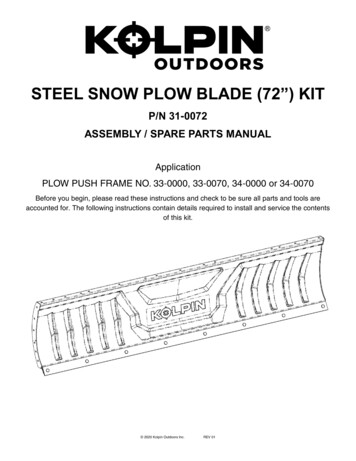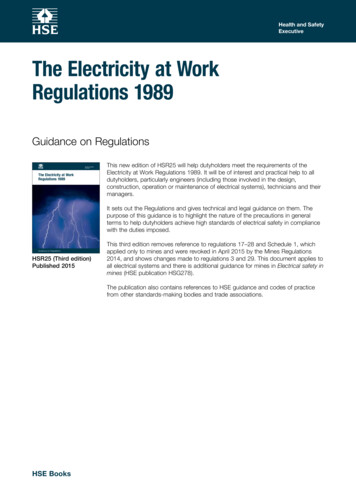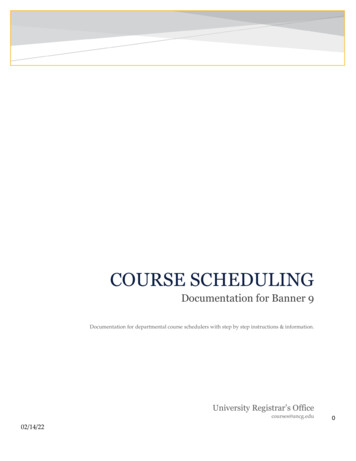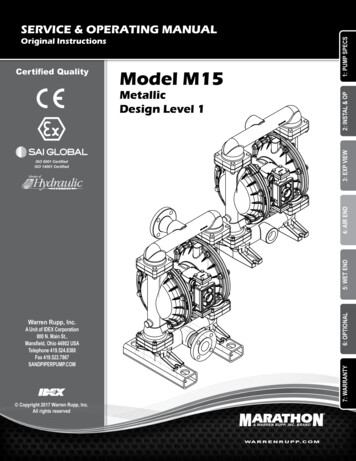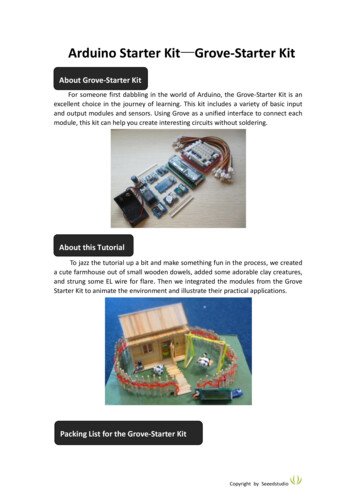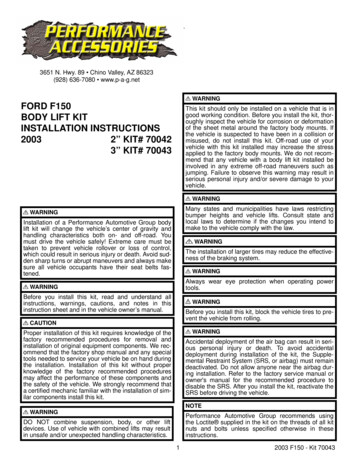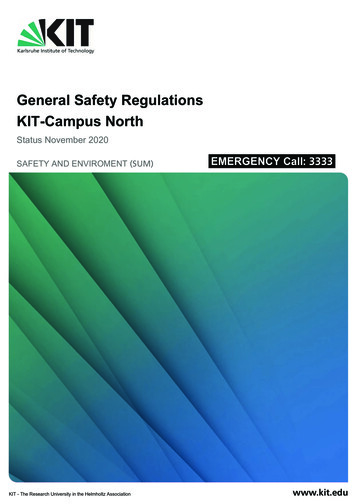
Transcription
General Safety RegulationsKIT-Campus NorthStatus November 2020SAFETY AND ENVIROMENT (SUM)KIT - The Research University in the Helmholtz AssociationEMERGENCY Call: 3333www.kit.edu
List of AbbreviationsAServAllgemeine Services (General Services)AServ-SDLAServ-SDL-CSIAServ – Hauptabteilung Sicherheitsdienstleistungen (AServ – SecurityServices Department)AServ – SDL – Campussicherheit (AServ – SDL – Campus Security)AServ-WFAServ – Werkfeuerwehr (AServ – SDL - Fire Department)AWZAbfallwirtschaftszentrale (Waste Management Center)BBSBeauftragter für die Biologische Sicherheit (GenTG, Biological SafetyCommissioner)EBEntsorgungsbetriebe der KTE (KTE Waste Management Facilities)FASStabsstelle Fachkräfte für Arbeitssicherheit (Specialists forOccupational Safety Staff Unit)FIZ Karlsruhe – Leibniz Institut für Informationsinfrastruktur (FIZKarlsruhe – Leibniz Institute for Information Infrastructure)FIZFMFacility ManagementFM-GM-VEAFM – Gebäudemanagement - Ver- und Entsorgungsanlagen (FM –Building Management – Supply and Waste Management Facilities)FTUGenTGFortbildungszentrum für Technik und Umwelt (Center for AdvancedTechnological and Environmental Training)Gentechnik-Gesetz (Genetic Engineering Act)GVOgentechnisch veränderter Organismus (genetically modified organism)IfSGInfektionsschutzgesetz (Infection Protection Act)ITOOrdnung der Transporte von radioaktiven Stoffen innterhalb desGeländes des Campus Nord des Karlsruher Instituts für Technololgie(Interne Transportordnung radioaktive Stoffe, Rules on InternalTransportation of Radioactive Substances on Campus North ofKarlsruhe Institute of Technology)Joint Research Centre KarlsruheJRC-KAKIT-CNKTEKarlsruher Institut für Technologie - Campus Nord (Karlsruhe Instituteof Technology - Campus North)KIT InformationsSystem Sicherheit” (KIT Information System onSafety) Intranetanwendung des KIT: https://www.kiss.kit.edu/ (Intranetapplication of KIT)Kerntechnische Entsorgung Karlsruhe GmbHPBPlanen und Bauen (Planning and Construction Projects)PLProjektleiter (Gentechnikgesetz; GenTG) (Project Head (GenTG))SEKSGBStrategische Entwicklung und Kommunikation (Strategic CorporateDevelopment and Communications)Sozialgesetzbuch (Social Code)SSBStrahlenschutzbeauftragter (Radiation Protection Commissioner)SSVStrahlenschutzverantwortlicher (Radiation Protection Supervisor)KISSi
StrlSchVStrahlenschutzverordnung (Radiation Protection Ordinance)SUMSicherheit und Umwelt (Safety and Environment)SUM-BGSUM – Beratung und Genehmigungen (SUM - Consulting andLicensing)SUM – Strahlenschutz (SUM – Radiation Protection)SUM-STSUM-ST-AZAGiiSUM – ST – Administrativer Strahlenschutz (SUM-ST – AdministrativeRadiation Protection)Zyklotron AG
Table of Contents1Introduction12General Rules of Conduct12.1Admittance into the Campus12.2Admittance Regulations for Visitors12.3Bringing along and Taking out Goods, Equipment, and Animals22.4Locking of Buildings and Rooms22.5Road Traffic on Site22.6Admittance Regulations for Specific Areas32.6.1Radiation Protection Areas32.6.2Biological Laboratories32.6.3Construction Sites32.7No Smoking, Fire, and Open Lights32.8Unauthorized Operating of Facilities and Equipment42.9Photography43Work Safety Regulations43.1General Work Safety Regulations43.2Handling Hazardous Substances43.3Preventive Medical Examinations, Fitness Examinations, Information Obligations53.4Fire Prevention Measures53.5Obligation to Report Accidents64Radiation Protection Regulations64.1Radiation Protection Areas74.1.1Admittance Requirements74.1.2Specific Requirements When Entering and Leaving Radiation Protection Areas in WhichUnsealed Radioactive Substances Are Handled84.2Radiation Protection Monitoring of Persons84.2.1Individual Dose Monitoring84.2.2Radiation Protection Instruction94.2.3Medical Surveillance and Information Obligations94.3Work with the Risk of an Increased Radiation Exposure94.4Safe Handling of Radiation Sources104.4.1General104.4.2Measures against External Radiation Exposure104.4.3Additional Measures for Handling Unsealed Radioactive Substances114.4.4Additional Measures When Handling Nuclear Fuels124.5Storage and Transport of Radioactive Substances124.6Removal of Materials from Radiation Protection Areas of KIT-CN124.6.1Transfer of Radioactive Substances to Another Area under a Separate Handling License13iii
4.6.2Delivery of Radioactive Residues to the State Collection Center of EB at KTE134.6.3Removal of Objects for Repair or Reuse134.6.4Transfer of Non-radioactive Substances to Unrestricted Reuse or Proper Disposal144.6.5Removal by Regular Waste Collections from Buildings, of Which Only Parts Have BeenDeclared Radiation Protection Areas145Regulations for Biological Laboratories with a Safety Classification145.1Areas, in Which Genetically Modified Organisms and Biological Substances Are Handled(Biological Protection Areas)145.2Admittance Requirements145.3Work in Biological Protection Areas155.4Instructions155.5Medical Surveillance and Information Obligations156Waste Disposal166.1Delivery of Wastes166.2Collection of Non-radioactive Wastes176.3Documents Accompanying Waste Transports177Water Protection Regulations177.1Sewage177.2Handling Substances Hazardous to Water188Regulations in the Event of an Alarm188.1Precautional Obligation to Inform188.2Notification in Case of an Alarm188.3Information about the Alarm198.4Emergency Measures198.5Task Force Management198.6Evacuation of KIT-CN198.6.1Evacuation Causes198.6.2Evacuation208.6.3Complete Evacuation208.6.4Evacuation of Parts of KIT-CN218.6.5Evacuation of Buildings and Facilities218.6.6Specific Regulations219Annexes229.1Annex I: Safety Organization of KIT-CN229.2Annex II: Special Safety9.3Annex III: Tasks of SUM, FAS, and AServ259.4Annex IV: Signs in the Workplace269.5Annex V: Clothes and Zone Rules When Handling Unsealed Radioactive Substances419.6Annex VI: Evacuation Areas429.7Annex VII: Commissioners and Bodies with Safety Functions43ivRegulations123
Introduction1 IntroductionIn these General Safety Regulations, Karlsruhe Institute of Technology – Campus North (KITCN) has compiled a set of instructions to ensure the safety of persons and property on itsoperating premises. These instructions are based on laws, ordinances, regulations, officiallicenses, licensing requirements, orders, as well as on generally recognized engineeringguidelines.Protection against danger is the responsibility of the safety organization outlined in Section 9.1.In addition to these General Safety Regulations, there are a number of Special SafetyRegulations applying to specific groups of persons or particular procedures. The most importantSpecial Safety Regulations are listed in Section 9.2.At the operation facilities of Kerntechnische Entsorgung Karlsruhe GmbH (KTE), internalregulations with equivalent contents shall have priority over the present General SafetyRegulations.If you have further questions concerning safety regulations, please consult the Safety andEnvironment Staff Unit, Consulting and Licensing Group (SUM-BG) or the Specialists forOccupational Safety Staff Unit (FAS).The latest version of these General Safety Regulations can be found on the Intranet of KIT atKIT Informationssystem Sicherheit (KISS): https://www.kiss.kit.edu/english/index.php.All organizational units mentioned in the present General Safety Regulations are located on thepremises of Campus North.2 General Rules of Conduct2.1Admittance into the CampusAdmittance into KIT-CN is only permitted to persons who possess a valid company pass orvisitor’s pass. By their signature when granted admittance into the campus, pass holders areobliged to observe and adhere to the safety regulations valid on KIT-CN.The company pass for employees is issued by the Campus Security Group of the SecurityServices Department of the General Services Business Unit on request of the HumanResources Business Unit. For employees of external companies and guests staying at anorganizational unit for a longer period of time, the company pass has to be applied for by thehead of this organizational unit. In case of employees of guest institutions, this guest institutionhas to submit the application. AServ–SDL–CSI makes and issues company passes afterpresentation of valid identity documents. The company pass must be shown unrequested to thestaff of AServ-SDL-CSI and must be surrendered on demand. When the period of employmentends, the company pass must be returned to the Reception Desk unrequested.Visitor’s passes are issued at the Reception Desk of AServ-SDL-CSI after presentation of avalid identity card or passport and proof that access to KIT-CN is necessary. The visitor’s passmust be shown unrequested to the staff of AServ-SDL-CSI and must be surrendered ondemand.On special order, security inspections of vehicles and carried-along boxes can be performed.2.2Admittance Regulations for VisitorsVisitors can enter the premises with a visitor’s pass. In the case that the visitor is unable to showany valid identification documents for the visitor’s pass to be issued, admission is only possible,1
General Rules of Conductwhen the visitor’s identity is confirmed by the host. Visiting groups may be given a group pass,provided that the group has been registered by AServ-SDL-CSI in the form of a list (with lastname, first name, date of birth, and place of birth) and constantly is under the direction of avisitor’s guide.Persons younger than 16 years are only allowed to enter KIT-CN, if a written agreement by thehead of the organizational unit to be visited has been submitted to the Reception Desk staff.Then, admittance is granted for this individual case and the rooms of the organizational unit tobe visited only.For admittance into radiation protection and security areas and into biological laboratories ofsafety category S2 according to the Genetic Engineering Act and Infection Protection Act,specific regulations apply (see Sections 4 and 5).2.3Bringing along and Taking out Goods, Equipment, and AnimalsWhoever wishes to bring along or take out goods or equipment, as long as these are no privatebelongings, has to indicate this unrequested to the staff of AServ-SDL-CSI. In principle, goodscan be brought in or taken out via the Central Delivery Gate (building 234). Employees of KITand of guest institutions on the site (e.g. FIZ, JRC-KA, KTE, and ZAG) can use the southernand northern gates for this purpose, provided that they can present the corresponding forms(e.g. Ein- und Ausfuhrpapiere, Leihschein, Versandschein).Persons bringing items into or acquiring items on KIT-CN must be able to present evidence ofownership when taking out these items from KIT-CN. It is not allowed to bring in items fordisposal.For further details concerning the taking out of materials (in particular waste etc.), it is referredto Sections 4.6 and 6.It is not permitted to bring into KIT-CN any animals, weapons (including imitation weapons orany items that look like weapons) or waste.In justified individual cases, the Chief Safety Officer may allow exceptions on request.2.4Locking of Buildings and RoomsWhen offices or laboratories are left unattended by persons working there for a longer period oftime during the day, they must be locked. This regulation also applies at the end of the workingday. After the normal working time, buildings must be locked.2.5Road Traffic on SiteOn KIT-CN, the provisions of the German Road Traffic Ordinance and the Road TrafficRegistration Ordinance apply. The speed limit is 50 km/h.AServ-SDL-CSI is responsible for traffic supervision. Directions and traffic regulation signs givenby uniformed staff of AServ-SDL-CSI must be obeyed. These take priority over general trafficregulations and specific local traffic signs.Doors and gateways must be kept clear. In particular, marked emergency and escape routes(e.g. access routes for the fire department vehicles) as well as roads and entrances to thebuildings must not be blocked by vehicles or objects.To ensure an efficient exit of vehicles from the parking lots in the case of an evacuation,vehicles have to be parked in a way that it is possible for all vehicles to leave unhindered.Industrial trucks (forklifts, electric trucks) may only be operated by persons in possession of a2
General Rules of Conduct“Fahrerausweis für motorisch angetriebene Flurförderzeuge” (driving license for motorizedindustrial trucks) and an authorization in writing by the respective organizational unit to operatethese vehicles for internal purposes.Other motorized vehicles of KIT may only be operated by persons in possession of a valid drivinglicense and a “Berechtigungsausweis zum Fahren von Kraftfahrzeugen des KIT” (authorizationto operate motorized vehicles of KIT).KIT vehicles not registered for use on public roads are not allowed to leave the fenced part ofKIT-CN.Washing and repairing of company vehicles are allowed in the corresponding facilities of KITCN only. Washing and repairing of private vehicles is forbidden on the premises of KIT-CN.2.6Admittance Regulations for Specific AreasSpecific areas of KIT-CN, in particular guest institutions, are divided off from the remaining siteby fences and other security measures and are placed under special surveillance. Movement ofpersons, vehicles, and materials across the boundaries of these areas is subject to specialregulations valid there.2.6.1Radiation Protection AreasAreas in which unsealed radioactive substances are allowed to be handled and controlled areasare specially divided off and marked (see Section 9.4). Access to these areas is subject tospecial requirements summarized in Section 4.2.6.2Biological LaboratoriesLaboratories that are classified in safety categories according to the Genetic Engineering Act orthe Infection Protection Act are specially marked (see Section 9.4). Starting from safety categoryS2, admittance into these areas is subject to special requirements summarized in Section 5.2.6.3Construction SitesConstruction sites are supervised by the responsible construction manager. Admittance ontothe construction site is only permitted with the consent of the construction manager and whenobserving the latter’s instructions.Construction site accommodation facilities (permanent or mobile) are only allowed to be setup with a permission (Baustelleneinrichtungsschein) from the Planning and ConstructionProjects Business Unit (PB). Such facilities may be inspected for safety by SUM-BG or theSpecialists for Occupational Safety.Fire and heating facilities may only be installed and operated with the permit of the FireDepartment (AServ-SDL-WF).2.7No Smoking, Fire, and Open LightsFire, open lights, and smoking are forbidden in specially signed areas. In addition, smoking isforbidden in all buildings, at the workplace, in forest areas, and in areas where unsealedradioactive substances or hazardous materials are handled.3
Work Safety Regulations2.8Unauthorized Operating of Facilities and EquipmentInterventions into machines, devices, and other working equipment may only be carried out byauthorized persons who are familiar with their operation, use, maintenance, and control.Devices and equipment of information technology may be put into operation by authorizedpersons only. It is the responsibility of each organizational unit to specify regulations for accessto and use of IT systems and to control compliance with these regulations.2.9PhotographyTaking photos, films, and videos on nonofficial occasions requires authorization. For takingphotos and recording outside of buildings, this authorization may be obtained from the StrategicCorporate Development and Communications Business Unit (SEK). For taking photos andrecording inside buildings, authorization may be obtained from the responsible head of theorganizational unit.3 Work Safety RegulationsSpecial safety regulations for work with radioactive substances and for work with geneticallymodified organisms and biological substances are outlined in Sections 4 and 5, respectively.3.1General Work Safety RegulationsFor all activities, the pertinent laws, ordinances, administrative regulations, accident preventionrules, and the recognized guidelines of engineering must be observed and applied.The most important work safety instructions are displayed at the organizational units. They canalso be found in KISS. Further information is given in the specifications and documentsdistributed by FAS to the heads of the organizational units and the Safety Commissionersaccording to Social Code VII. In case of questions, consult these persons and the responsibleSpecialists for Occupational Safety. If required, details can be found in KISS. Work safetyregulations can be requested from FAS.The most important warning signs are shown in Section 9.4.3.2Handling Hazardous SubstancesPersons handling hazardous substances must be informed by oral instructions. Herein, thesepersons are informed of potential hazards and ways of averting them at their specific workplacesbefore they start work. Instructions have to be repeated at regular appropriate intervals, at leastonce a year. The contents and date of the instruction must be recorded in written form andconfirmed by the signature of the person instructed. Attention must be paid to the operatinginstructions given by the organizational units.Pregnant or nursing mothers and persons younger than 18 years are subject to specialrestrictions when handling hazardous substances. For these persons, a workplace evaluationby the responsible Specialist for Occupational Safety and/or the company physician is requiredbefore starting such work.Internal transportation of hazardous substances must be in agreement with the “Regelung fürden innerbetrieblichen Transport von Gefahrstoffen auf dem KIT-Campus (TransportregelungGefahrstoffe, Rules on the Transportation of Hazardous Substances on the KIT Campus). Theserules can be found at https://www.kiss.kit.edu/1159.php.4
Work Safety Regulations3.3Preventive Medical Examinations, Fitness Examinations, InformationObligationsAccording to the Ordinance on Preventive Occupational Medical Care (ArbMedVV), preventivemedical examinations must be offered (optional examinations) or performed on a mandatorybasis (mandatory examinations) for the activities listed in the annex of this ordinance. Moreover,fitness examinations may be required by other legal regulations. In case of mandatoryexaminations, the activity may be started only after the examination has been carried out andparticipation has been certified. Fitness examinations prove that the said persons are fit for theirjob. In the case of optional examinations, the employees are free to let themselves be examined.Most preventive and fitness examinations must be repeated at regular intervals.To ensure central control of preventive and fitness examination dates, organizational units haveto register their employees for preventive medical examination with the Safety and onscanbefoundathttps://www.kiss.kit.edu/121.php. SUM informs the Medical Services Business Unit (MED) aboutthe examinations due and asks the employees to make an appointment with the MedicalServices in due time.Activities, during which pregnant or nursing mothers might be endangered by hazardouschemical substances, biological substances, and physical hazards (e.g. noise, vibrations, heat,etc.), require special evaluation. For this purpose, an additional risk assessment is made by theMedical Services (MED) and the Specialists for Occupational Safety (FAS).3.4Fire Prevention MeasuresAll work involving fire and explosive vapor/air mixtures, which is part of construction andmaintenance work on already used objects, may only be carried out with a “Erlaubnisschein fürSchweiß-, Schneid-, Löt-, Auftau- und Trennarbeiten” (permission form for welding, cutting,soldering, melting, and separation work).No permission is required for work involving fire in specially equipped laboratories or workshops.Permissions are issued by the Planning and Construction Projects Business Unit (PB) or theresponsible Operations Commissioner (Betriebsbeauftragter). The responsible OperationsCommissioner gives the permit to execute work only, if: Necessary requirements have been defined, the fire department has signed and, if necessary, completed the permission, all required safety measures have been taken, and the contractor (e.g. external company) has been informed about operations requirementsand other particulars.The respective organizational unit must ensure that the fire extinguishing equipment isoperational at all times. If fire alarm systems or parts of them are switched off for the executionof work for more than 15 minutes, surveillance of the respective area (guard or use of auxiliaryfire alarm systems) is required. Access to fire extinguishing equipment must not be blocked.Staff members will be instructed in the use of fire extinguishing equipment by the fire departmentat the request of the organizational units.Electrical cooking devices, such as coffee machines and hot plates, must be put on refractorystands or mats. These items should be used in the kitchens and amenities rooms only.5
Radiation Protection Regulations3.5Obligation to Report AccidentsIn the event of an accident, the Emergency Control Center (Alarmzentrale) must becalled. Dial 3333.In case of a work accident of an employee of KIT, the head of the corresponding organizationalunit must be informed. He/she has to complete the legally required accident report and toforward it to the Specialists for Occupational Safety (FAS). FAS forwards the accident report tothe Staff Council, the accident insurance company of KIT, and to the competent authority.In the case of an accident of employees of external companies and persons delegated to KIT,the head of the corresponding organizational unit and the superiors of the delegating companymust be informed. These are then obliged to report the accident to their accident insurancecompany. A copy of the accident report must be sent to FAS.An accident report must also be submitted for accidents occurring when carrying out officialactivities on the way to and from the workplace, during business trips, in sports within thecompany’s sports groups, or at internal community events. In case of doubt, information can beobtained from FAS.To ensure that all work accidents and accidents occurring on the way to and from theworkplace are reported in due time, you are required to report them to your superiors as soonas you either are involved in or witness such an accident.4 Radiation Protection RegulationsAny generation of ionizing radiation or handling of radioactive substances is subject to approvalor licensing by the respective authority. This means that all such activities are forbidden, unlessa license has been granted or laws and regulations permit an exception.Persons generating ionizing radiation or handling radioactive substances within the frameworkof a license granted must observe the Atomic Energy Act, the Radiation Protection Act, theRadiation Protection Ordinance, requirements outlined in the license issued according to theAtomic Energy Act or the Radiation Protection Act, instructions given by the authorities, andspecial operating instructions. The appointed Radiation Protection Commissioners areresponsible and authorized to give directions in matters of radiation protection. In mostorganizational units, the names of the competent Radiation Protection Commissioners can befound on a signboard in the entrance lobby. In case of doubt, ask the head of your organizationalunit or consult KISS (https://www.kiss.kit.edu/288.php).General radiation protection regulations are compiled in the “Strahlenschutzordner” (RadiationProtection File) distributed to each Radiation Protection Commissioner. The RadiationProtection File also contains supplementary provisions on reports for accounting andtransportation of radioactive substances. General radiation protection regulations can also befound in KISS.If applicable, further radiation protection instructions of the individual organizational units mustbe observed, which consider special circumstances at the corresponding facilities.Persons working with ionizing radiation or radioactive substances must be instructed onregulations relevant to their work and on potential risks and protection measures before startingtheir work. Then, these radiation protection instructions have to be repeated annually.Instructions are given and documented by the Radiation Protection Commissioner or a qualifiedperson appointed by him/her.6
Radiation Protection Regulations4.1Radiation Protection AreasIn radiation protection areas, failure to observe the applicable rules and regulations whenhandling radioactive substances and/or radiation sources may create hazards due to: External exposure to ionizing radiation, contamination through unsealed radioactivesubstances, incorporation of radioactive substances.According to these General Safety Regulations, radiation protection areas are: Controlled areas (Kontrollbereiche; areas, where effective doses may exceed 6 mSv/a), exclusion areas (Sperrbereiche; areas within a controlled area, in which the ambient doserate may exceed 3 mSv/h), supervised areas (Überwachungsbereiche; operating areas not belonging to a controlledarea, in which effective doses may exceed 1 mSv/a or areas, in which unsealedradioactive substances are handled above the exemption level (defined by the RadiationProtection Ordinance) or with an existing risk of contamination.Controlled and exclusion areas are marked at the entrance by a warning sign indicating potentialhazards (see Sections 9.4, 6).Controlled areas must be kept closed at all times.4.1.1Admittance RequirementsBefore entering a marked radiation protection area to carry out or maintain the operationprocesses intended, persons have to ask the competent Radiation Protection Commissioner forthe valid admittance regulations and the applicable rules of conduct in this area.Before persons work in a radiation protection area for the first time, they have to ask for specificinstructions by the competent Radiation Protection Commissioner or a qualified personappointed by him/her. In addition, these persons have to attend a radiation protection instructionsession and to undergo a medical examination, if necessary. In any case, anyone working in aradiation protection area must seek approval of the competent Radiation ProtectionCommissioner.Persons younger than 18 years and pregnant and nursing women are specially protected by theRadiation Protection Ordinance.As soon as they have informed their employer that they are pregnant or nursing, women mayonly work in radiation protection areas when the working conditions are such that internaloccupational radiation exposure is excluded and the responsible Radiation ProtectionCommissioner has agreed.Persons under the age of 18 are not allowed to handle unsealed radioactive substances withoutexplicit permission of the authorities, if a license is needed to handle the radioactive substances.Special regulations for admittance into controlled areas also apply to visitors. These regulationscan be found in KISS (https://www.kiss.kit.edu/1416.php) as well as in the Radiation ProtectionFile.7
Radiation Protection Regulations4.1.2 Specific Requirements When Entering and Leaving Radiation Protection Areasin Which Unsealed Radioactive Substances Are HandledOnly materials needed for the work at hand may be taken into radiation protection areas in whichunsealed radioactive substances are handled. It is forbidden to bring food, tobacco, beverages,and cosmetics into these areas.Books and journals from the KIT Library may not be brought into these areas. Books onpermanent loan, which are needed in these areas in exceptional cases, must remain there andmarked permanently.Protective clothing provided by the Radiation Protection Commissioner must be worn inradiation protection areas where there is a risk of contamination (Section 9.5). When leaving thearea, the protective clothing must be removed again. Hands, shoes, and, if applicable, clothesmust be subjected to a contamination control. The contamination monitors are installed at theexits of radiation protection areas with a risk of contamination. On suspicion of a personnelcontamination or when a contamination is detected by the monitor, the responsible radiationprotection staff must be informed immediately. Their radiation inspections and measures takenmust be waited for. When personnel contamination cannot be removed by simple means (e.g.washing) or on additional suspicion of incorporated radioactive substances, the RadiationProtection Commissioner or Emergency Control Center must be informed immediately. These,in turn, will inform the Medical Services. The phone numbers of the competent RadiationProtection Commissioner or the radiation protection staff are posted next to the contaminationmonitor. Further measures will be taken by the Medical Services. The affected persons arealways transported by special vehicles of the Medical Services.Items (materials and objects) to be removed from areas in which unsealed radioactive substances are handled are subject to special regulations (see Section 4.6).4.2Radiation Protection Monitoring of PersonsThe competent Radiation Protection Commissioner requests SUM-ST-A to includeoccupationally exposed personnel of KIT-CN in radiation protection monitoring using the form“Erhebungsbogen Strahlenschutz” (radiation protection registration form). Persons fromexternal companies that are occupationally exposed to radiation in the radiation protection areasof KIT-CN are dealt with by the central “Strahlenpassstelle” (Radiation Passport Office). Nonoccupationally exposed persons (personnel of KIT or persons from external companies) whowish to enter controlled areas of KIT-CN must also register with SUM-ST-A or the R
has to submit the application. AServ-SDL-CSI makes and issues company passes after presentation of valid identity documents. The company pass must be shown unrequested to the staff of AServ-SDL-CSI and must be surrendered on demand. When the period of employment ends, the company pass must be returned to the Reception Desk unrequested.



